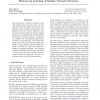Free Online Productivity Tools
i2Speak
i2Symbol
i2OCR
iTex2Img
iWeb2Print
iWeb2Shot
i2Type
iPdf2Split
iPdf2Merge
i2Bopomofo
i2Arabic
i2Style
i2Image
i2PDF
iLatex2Rtf
Sci2ools
ICML
2010
IEEE
2010
IEEE
Bottom-Up Learning of Markov Network Structure
The structure of a Markov network is typically learned using top-down search. At each step, the search specializes a feature by conjoining it to the variable or feature that most improves the score. This is inefficient, testing many feature variations with no support in the data, and highly prone to local optima. We propose bottom-up search as an alternative, inspired by the analogous approach in the field of rule induction. Our BLM algorithm starts with each complete training example as a long feature, and repeatedly generalizes a feature to match its k nearest examples by dropping variables. An extensive empirical evaluation demonstrates that BLM is both faster and more accurate than the standard top-down approach, and also outperforms other state-of-the-art methods.
| Added | 09 Nov 2010 |
| Updated | 09 Nov 2010 |
| Type | Conference |
| Year | 2010 |
| Where | ICML |
| Authors | Jesse Davis, Pedro Domingos |
Comments (0)

